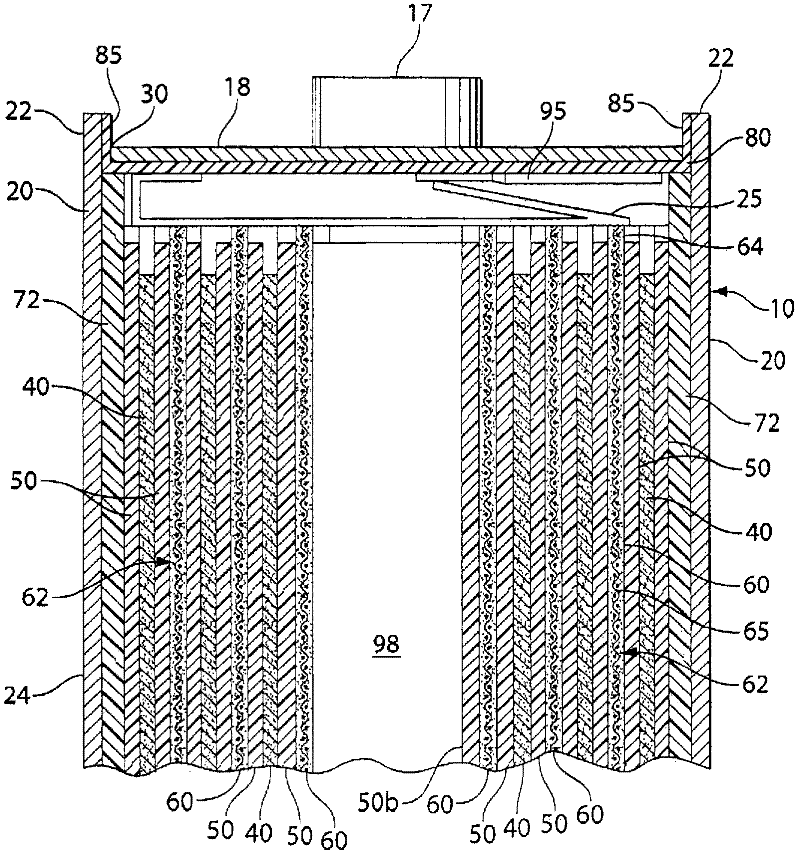Lithium cell with iron disulfide cathode
A battery and lithium salt technology, which is applied in the field of primary lithium battery cells, can solve the problems of impractical commercial use of batteries
- Summary
- Abstract
- Description
- Claims
- Application Information
AI Technical Summary
Problems solved by technology
Method used
Image
Examples
Embodiment A
[0061] has FeS 2 Experimental testing of the cathode of a lithium button cell
[0062] Experimental test Li / FeS was prepared as follows 2 Coin cell battery 100 ( Figure 1A ):
[0063] Test test battery components :
[0064] A nickel-plated steel cathode casing 130 in the shape of a coin and a nickel-plated steel anode casing (anode cover) 120 in the shape of a coin are formed by Figure 1A A similar configuration as shown in was formed. The finished battery 100 has a maximum diameter of about 25 mm and a thickness of about 3 mm. FeS in cathode casing 130 2 It weighs about 0.13 g and it covers both sides of the aluminum foil 115 . Because in this test cell 100 only the cathode side of the aluminum substrate sheet 115 facing the anode is dischargeable, the active FeS 2 The amount, that is, its actually dischargeable amount is about 0.065g. Lithium exceeds the theoretical capacity of the cathode.
[0065] In forming each cell 100, two stainless steel grids (316...
Embodiment B
[0149] Li / FeS with lithium alloy anode 2 Batteries Compared to Pure Lithium Metal Anode Batteries
[0150] Test AA size cylindrical cells were fabricated according to the foregoing description and represent specific embodiments of the invention. Three sets of batteries are tested: B, C and D. The control cell in all cases was Pack B, which had a lithium metal anode sheet 40, while Test Cells C and D both had a lithium anode sheet 40 alloyed with 1500 ppm aluminum. The electrolyte for each set of cells was the same except that sets B and C had 350ppm of water added to the electrolyte, while cell D had 425ppm of water added to the electrolyte. Otherwise, the batteries had the same contents and were prepared according to the same specifications.
[0151] The AA cells were all identical and were manufactured according to the following specifications.
[0152] Both sides of the aluminum foil substrate 65 of the cathode were coated in the form of a wet cathode slurry as pr...
PUM
| Property | Measurement | Unit |
|---|---|---|
| particle size | aaaaa | aaaaa |
| diameter | aaaaa | aaaaa |
| thickness | aaaaa | aaaaa |
Abstract
Description
Claims
Application Information
 Login to View More
Login to View More - R&D
- Intellectual Property
- Life Sciences
- Materials
- Tech Scout
- Unparalleled Data Quality
- Higher Quality Content
- 60% Fewer Hallucinations
Browse by: Latest US Patents, China's latest patents, Technical Efficacy Thesaurus, Application Domain, Technology Topic, Popular Technical Reports.
© 2025 PatSnap. All rights reserved.Legal|Privacy policy|Modern Slavery Act Transparency Statement|Sitemap|About US| Contact US: help@patsnap.com



